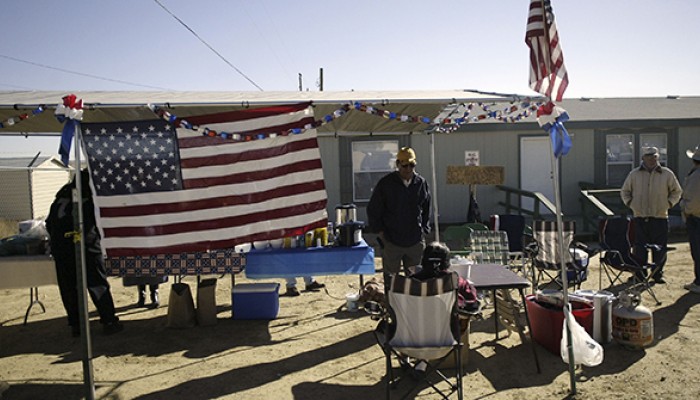The State of Native American Voting Rights
Lawmakers must seize new opportunities to ensure political equality and fair access to the ballot box for Native American communities.

Voting rights advocates have had much to celebrate in recent months: the pro-democracy wave of the 2018 election has carried momentum into 2019 both on the state level and federally with the recent passage of H.R.1 in the House of Representatives. These victories are important and real. But we must also use this moment to shine the light on an often-overlooked crisis in our democracy: the state of Native American voting rights.
Although Native Americans were legally named citizens of the United States in 1924, the road to the franchise was not an easy one. The right of Native Americans to vote in U.S. elections was recognized in 1948 with the landmark cases Harrison v. Laveen and Trujillo v. Garley. Even so, they were not eligible to vote in every state until 1962, when Utah became the last state to remove formal barriers.
But pernicious roadblocks remain to this day. Restrictive voting laws throughout the United States often carry a discriminatory effect, either by intent or consequence, for Native communities. Some of the major challenges to the ballot box faced by Native Americans include:
Restrictive voting laws that leave Native communities on the sidelines: Many Native Americans, especially those who live on reservations, do not have traditional street addresses. This has resulted in voter registration applications being rejected in many states. Even when accepted, the current format of registration forms often doesn’t incorporate this reality. States with voter ID laws often do not accept tribal IDs as a valid form of identification.
North Dakota, a state with a sizable Native population, serves as an ominous example. A 2017 voter ID law requires a physical address to vote. North Dakota failed to provide a physical address to many Native Americans. Even when the state did assign an address, this information was often not communicated to the individual, or the person was provided with multiple conflicting addresses. A lawsuit brought by the Native American Rights Fund (NARF) and two North Dakota tribes challenging the law found that some voters with IDs listing an assigned residential address had their absentee ballot applications rejected for having “invalid” addresses. While many local Native groups and individuals successfully mobilized to overcome these barriers before the 2018 election, the voter ID problem continues in the state.
The lack of proper allocation of election resources for Native communities: While often more pernicious, the lack of polling sites, infrastructure for early voting, and Election Day resources can have a crippling effect on voting. A 2017 survey of Native Americans by the Native American Voting Rights Coalition found that 32 percent of respondents in South Dakota said that the distance needed to travel to the polls affected their decision to cast a ballot. The limited amount of polling sites and drop boxes for absentee ballots caused some on reservations to have to drive 150 miles to vote.
Shortly following the 2018 midterms, the Navajo Nation in Arizona filed a lawsuit alleging that state and county polling procedures violated the Voting Rights Act. The suit claimed that the minimal number of polling locations in reservation counties, inaccurate information provided by poll workers, and lack of interpreters for non-English speakers effectively disenfranchised many voters.
Removal of federal protections: Prior to the 2013 Supreme Court ruling in Shelby County v. Holder, the preclearance requirement of the Voting Rights Act provided federal protections to many Native Americans. Under preclearance, states with a history of discriminatory voting practices were required to get approval from the DOJ or a D.C. District Court before implementing any voting changes.
Alaska and Arizona, home to sizable Native American communities, were among the nine states covered as a whole under preclearance. And the two South Dakota counties covered by preclearance (Oglala Lakota County and Todd County) contain the Pine Ridge and Rosebud Indian reservations, respectively.
In the years since Shelby County, which effectively ended preclearance, many previously covered jurisdictions have put new voting restrictions in place. Arizona recently made it a felony to collect and turn in another voter’s completed ballot, even with that voter’s permission. While it is hard to say whether such a bill would have been prohibited by preclearance, increased federal protections would go far to ensure that states honor the right of Native Americans to vote.
These hurdles have real effects: statistics from the National Congress of American Indians show that the turnout rate of American Indian and Alaska Native registered voters is between 5 to 14 percentage points lower than turnout rates of other racial and ethnic groups.
The good news is that bills currently at the state and federal level exist that could help right this historic wrong. This past weekend, the Native American Voting Rights Act passed the Washington State legislature with deep bipartisan support. Among other things, the bill allows Native Americans to use nontraditional addresses if living on a reservation and permits tribes to request more election resources from the state.
On the federal level, civil rights organizations such as the NARF have spearheaded a congressional effort to pass the federal version of Native American Voting Rights Act. The Act would create more communication channels between Washington and Native American tribes, direct states to accept tribal ID cards for voting purposes, and establish a clear pathway for Native communities to request federal election observers.
Lawmakers must seize these opportunities and ensure political equality and fair access to the ballot box for Native American communities. It is way overdue.
(Image: Rick Scibelli/Getty)



